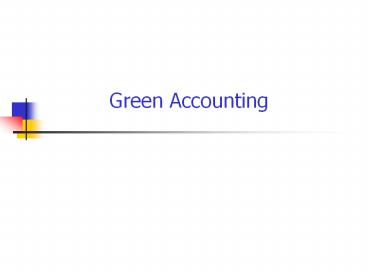Green Accounting - PowerPoint PPT Presentation
Title:
Green Accounting
Description:
Title: NEEDS WS3a WP5: Green Accounting - Some thoughts! Last modified by: iLLuSioN Document presentation format: On-screen Show Other titles: Arial Times New Roman ... – PowerPoint PPT presentation
Number of Views:208
Avg rating:3.0/5.0
Title: Green Accounting
1
Green Accounting
2
EU Policy Context
- Lisbon (economic and social)
- Gothenburg (environment)
- Climate change
- Sustainable transport
- Public health
- Resource management
- Green accounting links economic and environmental
objectives
3
Overview of Presentation
- Green (environmental) accounting
- Rationale
- Elements of Green Accounting Theoretical
conceptual basis - Empirical progress in different contexts
- Conclusions for research and practical
applications.
4
Rationale for conventional accounting
- Measurement of economic activity - production
GDP - Often used as indicator of welfare
- Two elements of accounts
- Changes in Stocks of Capital - Investment
- Measurement of production/output Flows -
Consumption
5
Standard National Accounts (SNA) framework
- NNP C I D X M
- Where
- NNP Net National Product
- C Consumption
- I Investment
- D Depreciation
- X Exports
- M Imports
- Misleadingly used as measure of welfare welfare
not proportionate to consumption of produced goods
6
Green accounting rationale
- The effect of mankinds activity upon the
environment has been an important policy issue
throughout the last part of the twentieth
century. - increasing recognition that continuing economic
growth and human welfare are dependent upon the
services provided by the environment - Source The United Nations Handbook of National
Accounting - Integrated Environmental and
Economic Accounting - Economic Environmental linkages have
implications for meso- and macro-economic
management - Meso/macro-economic management more responsive to
environment if environmental indicators exist
7
Elements of Green Accounting - Outline
- Environmental services
- Ecosystem life support systems
- Landscape
- Environmental damages
- Pollution flows e.g air water quality
- Defensive (environmental protection) expenditures
- e.g. noise reducing windows IPPC technologies
- Resource depletion
- Non-renewables renewables
8
Empirical progress in Environmental Accounting in
different contexts some evidence
9
- UN initiative on Green Accounting UNSEEA (1993,
2000, 2003)
- System of integrated Environmental and Economic
Accounting (SEEA) complements SNA method for
measuring economic activity - Adds environmental information to existing
Input-Output economic data - Physical stock and flow tables
- Hybrid (physical monetary) stock and flow
tables - Methodological guidance on resource depletion,
degradation, defensive expenditures
10
Physical monetary stock and flow tables
- Often known as NAMEAs (National Accounting Matrix
including Environmental Accounts). - Physical flow accounts include four types of
flow - products (produced in the economic sphere and
used within it), - natural resources (mineral, energy, biological),
- ecosystem inputs (air and water) and
- residuals (solid, effluent, emissions).
- Each of these accounts is expressed in terms of
supply to, and use by, the economy. - i.e. tables represent the flows between the
economy and the environment.
11
An indicator of weak sustainability genuine
savings
- Genuine Savings monetary savings less the
depreciation on manmade capital less the
depletion of natural capital. (From S Iv
identity) - Value of changes in economys overall capital
stocks. - Negative genuine saving corresponds to
unsustainability, since if depleting capital
stock, can receive lower welfare from it in
future - Genuine Savings rates low or negative for
Sub-Saharan Africa and for Middle East and North
Africa. - Assumes all capital is substitutable
12
Genuine savings for Tunisia, as of GDP
13
The Index of Sustainable Economic Welfare (ISEW)
- ISEW (Daly and Cobb (1989))
- current welfare should be measured as the current
flow of services from all sources, rather than
current output of marketed goods - E.g.
- value for leisure time to correct for the fact
that welfare could increase while NNP decreases
if people choose to work less - higher incomes of urban residents are
compensation for externalities connected with
urbanisation and congestion, ? proportion of
income should not be included as welfare
14
- The Index of Sustainable Economic Welfare (ISEW)
- ISEW
- Consumption Investment Extra-Market services
Consumer Durables Services Services of Roads
Public Health Education Consumer Durables
Expenditure Private Defensive Expenditure on
Health /Education Advertising Commuting
costs Pollution costs cost of loss of
ecosystems resource depletion costs Long
term environmental damage - Applications at national level UK, Sweden,
Netherlands, Italy, Poland, Austria - Applications at local level Siena (Pulselli et.
al. 2006) - Problem mixes sustainability and
welfare issues in single measure
15
Index of Consumption Corrected for Environmental
Damage (ICCED)- EC Greensense project
- ICCED developed
- to demonstrate how well-being changes over time
if sustainability standards imposed and effects
of environmental damage are accounted for. - corrects for environmental damage and expenditure
incurred under sustainability policies
(similarities with local EcoBudget initiatives
e.g. Roma)
16
Sustainability targets analysed under the
GREENSENSE project
17
Greensense Environmental impacts on welfare (UK)
18
Greensense ICCED Measures - UK
19
Summary of Empirical initiatives
- NAMEA includes environmental issues within
standard accounting framework - Genuine savings sustainability-related decision
rule - ISEW broader interpretation of welfare
- ICCED includes welfare effects of meeting
sustainability targets
20
Conclusions on Green Accounting
- Recognition of need to address both current
welfare and sustainability issues from
macro-perspective - National and international initiatives (e.g. UN
SEEA, 2003) are developing improved methodologies - Variety of initiatives reflects lack of consensus
on priorities and methods - Local applications of methods can reflect
regulatory responsibilities but may be difficult
to define sustainability at this scale? - Applications very data-hungry and modelling
intensive





















![READ[PDF] The Green Road: A Novel PowerPoint PPT Presentation](https://s3.amazonaws.com/images.powershow.com/10053136.th0.jpg?_=20240611070)


![READ⚡[PDF]✔ 101 Gardening Jokes: 101 Hilarious Jokes for Green-Thumbed Gardeners! PowerPoint PPT Presentation](https://s3.amazonaws.com/images.powershow.com/10085112.th0.jpg?_=20240724072)
![Download [PDF] Green Smoothie and Juicing Recipe Book: Detoxify, Energ PowerPoint PPT Presentation](https://s3.amazonaws.com/images.powershow.com/10088178.th0.jpg?_=20240729069)



![READ [PDF] Green Shade: Accountants Aren’t Supposed To Die This Way PowerPoint PPT Presentation](https://s3.amazonaws.com/images.powershow.com/10104918.th0.jpg?_=20240823019)
![[READ DOWNLOAD] Green's 2024 Trader Tax Guide PowerPoint PPT Presentation](https://s3.amazonaws.com/images.powershow.com/10104919.th0.jpg?_=20240823019)
